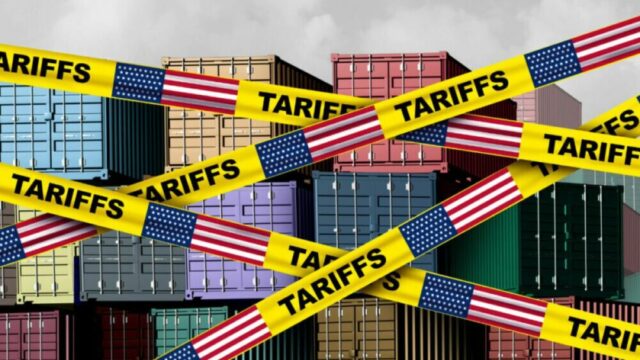Tariff Men

President Trump’s tariffs are a return to America’s prosperous past.
In the wake of Franklin Roosevelt’s creation of the Administrative State, the GOP was forced to abandon its early twentieth century economic ideas in order to survive electorally, including a longstanding commitment to funding the Federal budget through tariffs. This commitment was already weakening before the Depression, thanks to the Wilson Administration’s reorganization of the tax code. But FDR cemented it. Tariffs were held to be incompatible with America’s changed system of government, and new place in the global order.
This status quo persisted until Donald Trump suddenly resurrected the topic in the closing weeks of his Presidential election campaign. Trump spoke of tariffs in almost devotional terms, calling them “the most beautiful word in the dictionary,” pointing out that America was “at the richest point in its history in the 1890s,” and commending President McKinley as the “Tariff King.”
Tariffs go back to the birth of the United States. Following the War of Independence, one of the most difficult issues facing the new nation was how to pay off the colonies’ Revolutionary War debts, without substantially raising taxes and therefore immediately alienating a people who had revolted precisely against excessive taxation. Tariffs were the answer. The first piece of Congressional Legislation signed by President Washington was the Tariff Act of 1789. From this point until the 1910s, they would continue to serve as the primary source of the federal government’s revenue. Even Thomas Jefferson, a critic of the Constitution and early opponent of tariffs, which he denounced as a tool of a tyrannical and centralized state, employed them when he was President as a useful tool against European incursions into the new world.
After the growing American economy began exporting raw material, agricultural goods, and industrial products overseas, the question of the use of tariffs returned in a new form. During the War of 1812 the British not only blockaded the American coast, but attacked American vessels carrying goods to France. After that conflict ended in stalemate (the borders between the US and British Canada remained unchanged), America was forced to reassess its geopolitical position. A split emerged. One side favored pursuing a new relationship with the British Empire through strengthened economic ties, and in particular by selling Southern Cotton to Britain’s powerful textile industry. The other side took a radically different view: America would forge its destiny not through international trade, but in its own self-sufficient national economic system.
From this second school of thought emerged two highly influential statesmen: Henry Clay, and William McKinley. Clay, born in Virginia during the Revolutionary War, developed his political vision under the mentorship of George Wythe, Thomas Jefferson, and James Madison, and through the lens of hardship and war. He believed America would only reach its potential if it could avoid falling back into the clutches of the British Empire.
Having played a key role in supporting the tariffs of 1816 and 1824, Clay gave a series of rousing speeches in the Senate in February 1832 outlining the political and economic vision that he called the “The American System.” Defending tariffs, Clay excoriated the Congressmen who were warming up to the idea of pursuing a free trade policy with Great Britain, calling them “foreigners who never become naturalized,” and “alien” in their hearts, urging free traders to “go home to their native Europe” and convince everyone there to buy American product before they dared return to the American homeland.
Clay saw the tariff system (as well as the creation of a national Bank, roads, and canals) as the key to connecting individual regions to the rest of the nation. Tariffs were a matter of national self-determination. Free Trade, on the other hand, Clay denounced as “a mere revival of the British colonial system.” At one point, he cried out, “Was there ever a scheme more artfully devised, by which the energies and faculties of one people should be kept down and rendered subservient to the pride, and the pomp, and the power of another!”
Clay’s ideas about the American System were not adopted, but tariffs remained. For the rest of the 19th century, it was alternately lowered and raised, but never cast off fully. Meanwhile Americans grew richer in ways that a 1750s Colonist would be unable to fathom.
Today it is widely claimed that Trump’s tariffs will lead to trade war and commercial ruin: the policy is decried as archaic mercantilism, destined to destroy not only America but its international allies as well. Both Left and Right, from CATO libertarians to progressive socialists, dance to the song of free trade. But trade is not merely a frictionless exchange of capital, it is a political question which ultimately touches on questions of sovereignty. One nation’s powerful economy, freely trading with another nation’s weaker economy, will cause the first nation to acquire capital within the other’s economy and consequently political influence: influence that then exerted towards the first nation’s own ends.
Free Trade was not what transformed Britain into the world’s largest empire, but a strategy that Britain embraced after it had become world number one through protectionism. The United States followed the same path. Free trade was the policy that built the foundation of globalism, and it is tariffs that will be the primary agent of deglobalization.

William McKinley ascended to the Presidency on a platform of economic nationalism a few decades after Britain had begun its turn toward free trade. Both American workers and American capital benefited from his high-tariff, hard-money policy, which generated a huge surplus that he planned to use on the military, infrastructure and public works, including plans to build a South American canal. McKinley essentially applied Clay’s idea of the American System to the Monroe Doctrine in the cause of establishing American hegemony over the whole Western Hemisphere. Eventually, the canal was built by Teddy Roosevelt, once he took the Presidency after McKinley’s tragic assassination.
McKinley’s greatest skill was his ability to communicate the wishes of the common man. As a Congressman he had argued against the lowering of tariff duties by pointing out that lowering them would not lead to lower prices, but rather to lower wages and lower domestic production. He argued that the world markets of the 1890s were “a snare and a delusion,” and that American economic power on the global markets depended on underselling its competitors, and that “our tariffs do not keep us out, and free trade will not make it easier to enter them.”
McKinley’s understanding of economics grew out of the American School of Political Economy: a school of thought which argued that measuring wages, prices, and production against each other was the best way to understand the health of an economy. With this in mind, the American School argues for intense protection around the walls of America’s economy: tariffs prevent products made by low-wage workers from undercutting American products and workers. But the American School also counters left-wing hostility to capital by minimizing domestic barriers to commerce, allowing productivity and wages to rise faster than prices.
McKinley’s America was protected from the world and connected to itself. But his economic system was dismantled piece-by-piece over the next half-century. Tariff duties were lowered, free trade was embraced, the gold standard was abolished, and American cities became synonymous with American decline.
Trump’s tariffs are currently being used essentially as coercive tools of foreign policy. But they have the potential to do more. The first stage involves ratcheting up tariff duties (and bringing back some tariffs which had wholly disappeared from the scene) in order to compel multinational corporations to relocate their factories and businesses to America. This brings jobs and production back to America, while also ensuring that the wages are not undercut. As incomes rise and spending power increases, taxes can be slashed, because tariff revenue and exports will replace them.
Trump has floated the abolition of Wilson’s income tax, but tariffs will not be able to bring in enough revenue to replace it. That means a major part of the Administrative State built by FDR and expanded by LBJ will need to be liquidated. DOGE cuts must be almost absolute before a true American economic revival becomes possible. But revival is at least now conceivable. Trump has put the pieces in place for the tear-down of the US government’s worst excesses, and the rebuilding of the America once envisioned by Clay and McKinley. Tariffs are the key to unlocking this great American future.
